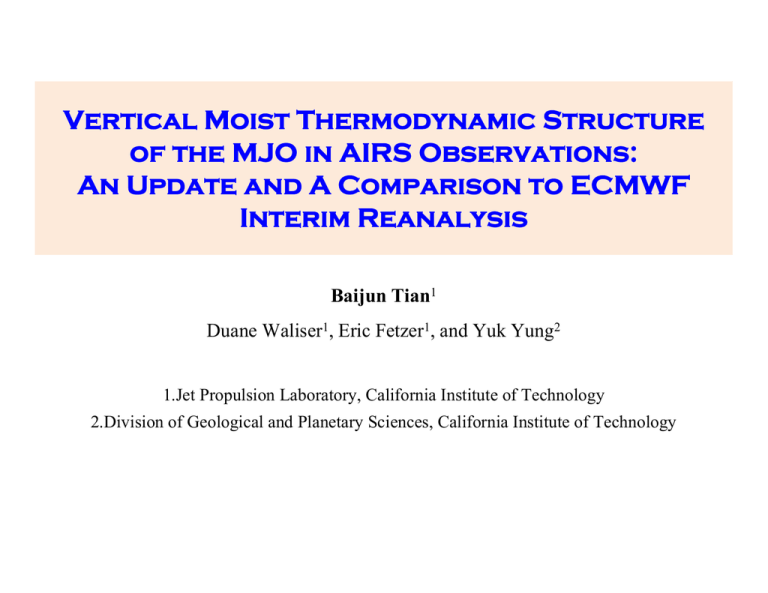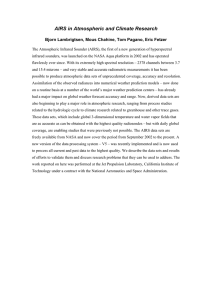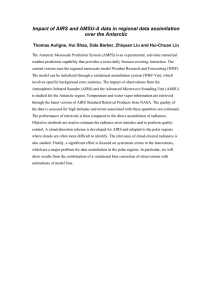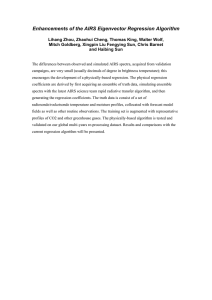Vertical Moist Thermodynamic Structure of the MJO in AIRS Observations:
advertisement

Vertical Moist Thermodynamic Structure of the MJO in AIRS Observations: An Update and A Comparison to ECMWF Interim Reanalysis Baijun Tian1 Duane Waliser1, Eric Fetzer1, and Yuk Yung2 1.Jet Propulsion Laboratory, California Institute of Technology 2.Division of Geological and Planetary Sciences, California Institute of Technology Madden-Julian Oscillation (a.k.a. Intraseasonal Oscillation) ² The MJO is characterized by slow eastward-propagating oscillations in tropical deep convection and large-scale circulation. ² It is the dominant form of intraseasonal variability in the Tropics. ² It impacts a wide range of phenomena. ² It is predictable within 2-4 weeks. ² Our weather & climate models have a relatively poor representation. ² A comprehensive theory for the MJO is still lacking. Madden & Julian [1971; 1972], Lau and Waliser [2005], Zhang [2005] 2 Tian, B., et al., 2006: Vertical moist thermodynamic structure and spatial‐ temporal evolution of the MJO in AIRS observations. J. Atmos. Sci., 63, 2462‐ 2485, doi:10.1175/JAS3782.1. -20 Days -10 Days 0 Days +10 Days +20 Days Over the Eastern hemisphere, enhanced (suppressed) convection is generally preceded in both time and space by a low-level warm and moist (cold and dry) anomaly and followed by a low-level cold and dry (warm and moist) anomaly. 3 Tian, B., et al., 2006: Vertical moist thermodynamic structure and spatial‐ temporal evolution of the MJO in AIRS observations. J. Atmos. Sci., 63, 2462‐ 2485, doi:10.1175/JAS3782.1. Indian Ocean NCEP Western Pacific Ocean AIRS NCEP AIRS Major differences in the lower-tropospheric moisture and temperature structure between AIRS and the NCEP/NCAR reanalysis are found over the Indian and Pacific Oceans. 4 Limitation of Tian et al. (2006) Only 2.5 years (2002-2005, 8 MJO events) of V4 AIRS data were used. 5 Objective Here, we further examine the large-scale vertical moist thermodynamic structure of the MJO using currently available 7year V5 AIRS data (2002-2009; 17 MJO events) to test its dependence on the AIRS data record lengths, AIRS retrieval versions and MJO event selection and compositing methods employed. We also compare the large-scale vertical moist thermodynamic structure of the MJO between AIRS and the newer ECMWF Interim reanalysis (ERA-Interim) to evaluate the performance of ERA-Interim in describing the large-scale vertical moist thermodynamic structure of the MJO. 6 Data ² TRMM 3B42 Rainfall: 40S-40N, 0.25° x 0.25°, 3-hourly, 01/01/1998-05/31/2009. Huffman et al. (2007) ² AIRS Temperature & H2OVapMMR global, 1.0° x 1.0°, V5, L3, 2xdaily, 09/01/2002-06/30/2009. 24 pressure levels for Temp and 12 layers for H2OVapMMR. Chahine et al. (2006) ² ECMWF Interim Reanalysis Temperature & Specific Humidity global, 1.5° x 1.5°, 4xdaily, 09/01/2002-05/31/2009. 37 pressure levels from 1000 to 1 hPa for both temperature and specific humidity. 7 MJO Analysis Methods (1) Method 1 is the Extended EOF (EEOF) method used by Tian et al. (2006). (2) Method 2 is the Multivariate EOF (MEOF) method introduced by Wheeler and Hendon (2004). 8 EEOF Method (1) All the data were binned into pentad (5-day) values. (2) Intraseasonal anomalies were obtained by removing the annual cycle and data filtering through a 30–90-day band pass filter. (3) Perform an EEOF analysis on band-passed (30-90 day) rainfall data (e.g., TRMM, CMAP) over the tropical Indian Ocean and western Pacific. (4) Identify MJO events from the PC time series of 1st EEOF mode. (5) Composite MJO events in band-passed rainfall and target quantity (e.g., temperature, moisture, ozone, aerosols). Tian et al. (2006) 9 Spatialtemporal Pattern of the 1st EEOF Mode of Rainfall MJO Anomaly 1998-2005 Tian et al. (2006) 10 Amplitude Time Series of the 1st EEOF Mode of Rainfall MJO Anomaly The x indicates the dates of selected MJO events for 2002-2005 (8) The x indicates the dates of selected MJO events for 2002-2009 (17) 11 MEOF Method (1) Intraseasonal anomalies of daily data were obtained by removing the climatological seasonal cycle and data filtering through a 30–90-day band pass filter. (2) Perform a multivariate EOF analysis on band-passed (30-90 day) NOAA OLR and NCEP/NCAR 850- and 200-hPa zonal winds. (3) The MJO phase for each day is determined by the Real-time Multivariate MJO (RMM) index (a pair of PC time series called RMM1 and RMM2 based on the leading pair of the multivariate EOFs). (4) A composite MJO cycle (8 phases) was calculated by averaging band-passed daily anomalies of target quantity for each phase of the MJO cycle. Wheeler and Hendon (2004) 12 Spatial Structures of EOF 1 & 2 EOF1 describes the situation when the MJO produces enhanced convection (negative OLR anomalies) at the Maritime Continent (MC): low-level westerly wind anomalies extend throughout the Indian Ocean (IO) and MC, and low-level easterlies exist across the Pacific, while upper-level wind anomalies are in the opposite direction to those below. EOF2 has enhanced convection over the Pacific Ocean and wind patterns that are in close quadrature to those of EOF1. Together, they describe the key features of the MJO, such as eastward propagation of convection anomalies in the Eastern Hemisphere; out-of-phase relationship between lower and uppertropospheric wind anomalies; the predominance of lower-tropospheric westerly anomalies near and to the west of enhanced convection. 13 The RMM Index for AIRS Period 14 RMM Phase Space for AIRS Period 15 Comparison of V4 and V5 2.5-yr V4 AIRS data & EEOF method 2.5-yr V5 AIRS data & EEOF method 16 Comparison of V4 and V5 2.5-yr V4 AIRS data & EEOF method 2.5-yr V5 AIRS data & EEOF method 17 Comparison of 2.5- and 7-yr 2.5-yr V5 AIRS data & EEOF method 7-yr V5 AIRS data & EEOF method 18 Comparison of 2.5- and 7-yr 2.5-yr V5 AIRS data & EEOF method 7-yr V5 AIRS data & EEOF method 19 Comparison of EEOF and MEOF 7-yr V5 AIRS data & MEOF method 7-yr V5 AIRS data & EEOF method 20 Comparison of EEOF and MEOF 7-yr V5 AIRS data & MEOF method 7-yr V5 AIRS data & EEOF method 21 Comparison of AIRS and ECMWF 7-yr V5 AIRS data & MEOF method 7-yr ERA data & MEOF method 22 Comparison of AIRS and ECMWF 7-yr V5 AIRS data & MEOF method 7-yr ERA data & MEOF method 23 Summary There is a strong consistency of the large-scale vertical moist thermodynamic structure of the MJO between different AIRS data record lengths (2.5 versus 7 years), different AIRS retrieval versions (4 versus 5) and different MJO event selection and compositing methods (the EEOF method used by Tian et al. (2006) versus the MEOF method used by Wheeler and Hendon (2004)). Deficiencies still exist in the ERA-Interim describing the largescale vertical moist thermodynamic structure of the MJO although ERA-Interim seems doing much better than NCEP/NCAR in this regard. This characterization of the large-scale vertical moist thermodynamic structure of the MJO by AIRS offers a useful observation-based metric for climate model diagnostics. 24 Comparison of V4 and V5 25 Comparison of 2.5- and 7-yr 26 Comparison of 2.5- and 7-yr 27 Equatorial West Pacific (150-160E, 8S8N) Equatorial Indian Ocean (90-100E, 8S8N) 28 AIRS ERA Equatorial IO & WP (50-210E, 8S8N) Equatorial Indian Ocean (70-100E, 8S8N) 29 Amplitude Time Series of the 1st EEOF Mode of Rainfall MJO Anomaly The x indicates the dates of selected MJO events for 2002-2005 (8) 30



